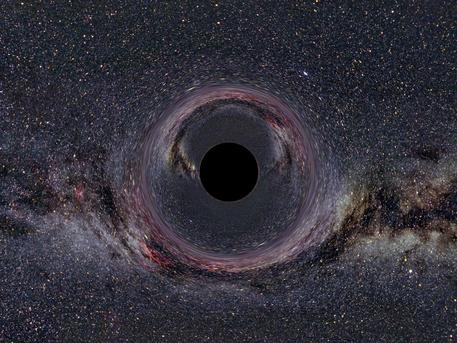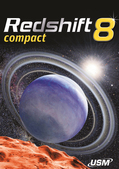Seeing the Unseeable
How Is A Black Hole Discovered?
Black holes are astrophysical objects with an almost unbelievably high mass per unit volume. They are so heavy that they are able to powerfully warp the space around them. Within a certain distance from the black hole – the 'event horizon' – this warping of space is so strong that absolutely no light or any other radiation can leave.
 © Ute Kraus (CC-BY-SA 2.0)
|
The computer-generated image shows a fictitious black hole the equivalent of 10 times the Sun's mass, viewed from a distance of 370 miles. In the background the Milky Way appears distorted due to the curvature of space.
Hence black holes – as the name implies – appear completely black to the human eye. Therefore, by definition or in accordance with Albert Einstein's General Theory of Relativity, black holes cannot be observed. So how do astrophysicists know that they exist?
In fact, there is a lot of 'circumstantial evidence' that indirectly demonstrates the existence of black holes. At the center of the Milky Way, there are stars that move around an invisible concentrated mass at high speed. The course of their orbits argues for the existence of a black hole.
Matter in the vicinity of a black hole is attracted by its gravity but is unable to fall directly into the center of the black hole due to its angular momentum. If the black hole is surrounded by interstellar gas, it first accumulates in what is known as an 'accretion disc'. Due to the friction between the accumulated particles and due to magnetic fields, the disc heats up and then shines in all the colors of the spectrum. This radiation can be measured using modern telescopes.
Strange giants – not visible, but influential
If a star gets too close to a black hole, it gets spectacularly torn apart and in the process emits characteristic X-ray radiation. The curvature of space caused by black holes influences the path of the light. Light rays do not pass by a mass such as this in a straight line; they are instead diverted as if by an optical lens made of glass – black holes can act as 'gravitational lenses'. (See: What are gravitational lenses?). If we observe a contorted orbit for a particular star, we can conclude that this is due to the nature of the gravitational lens.
An additional effect of black holes will probably be able to be verified when radio telescopes are interconnected in the next few years. Radiation from areas slightly outside the event horizon is strongly suppressed due to relativistic effects. This dark zone – the 'shadow of the black hole' – is still too tiny to be able to be recognized using today’s telescopes.
When astrophysicists identify black holes they therefore use the same method as the detective we know from novels, Sherlock Holmes. They make highly accurate observations, collect information and then analyze it using logical conclusions. Modern telescopes have taken the place of the magnifying glass.
German Aerospace Center
In fact, there is a lot of 'circumstantial evidence' that indirectly demonstrates the existence of black holes. At the center of the Milky Way, there are stars that move around an invisible concentrated mass at high speed. The course of their orbits argues for the existence of a black hole.
Matter in the vicinity of a black hole is attracted by its gravity but is unable to fall directly into the center of the black hole due to its angular momentum. If the black hole is surrounded by interstellar gas, it first accumulates in what is known as an 'accretion disc'. Due to the friction between the accumulated particles and due to magnetic fields, the disc heats up and then shines in all the colors of the spectrum. This radiation can be measured using modern telescopes.
Strange giants – not visible, but influential
If a star gets too close to a black hole, it gets spectacularly torn apart and in the process emits characteristic X-ray radiation. The curvature of space caused by black holes influences the path of the light. Light rays do not pass by a mass such as this in a straight line; they are instead diverted as if by an optical lens made of glass – black holes can act as 'gravitational lenses'. (See: What are gravitational lenses?). If we observe a contorted orbit for a particular star, we can conclude that this is due to the nature of the gravitational lens.
An additional effect of black holes will probably be able to be verified when radio telescopes are interconnected in the next few years. Radiation from areas slightly outside the event horizon is strongly suppressed due to relativistic effects. This dark zone – the 'shadow of the black hole' – is still too tiny to be able to be recognized using today’s telescopes.
When astrophysicists identify black holes they therefore use the same method as the detective we know from novels, Sherlock Holmes. They make highly accurate observations, collect information and then analyze it using logical conclusions. Modern telescopes have taken the place of the magnifying glass.
German Aerospace Center
Seeing the Unseeable
How Is A Black Hole Discovered?
Black holes are astrophysical objects with an almost unbelievably high mass per unit volume. They are so heavy that they are able to powerfully warp the space around them. Within a certain distance from the black hole – the 'event horizon' – this warping of space is so strong that absolutely no light or any other radiation can leave.
 © Ute Kraus (CC-BY-SA 2.0)
|
The computer-generated image shows a fictitious black hole the equivalent of 10 times the Sun's mass, viewed from a distance of 370 miles. In the background the Milky Way appears distorted due to the curvature of space.
Hence black holes – as the name implies – appear completely black to the human eye. Therefore, by definition or in accordance with Albert Einstein's General Theory of Relativity, black holes cannot be observed. So how do astrophysicists know that they exist?
In fact, there is a lot of 'circumstantial evidence' that indirectly demonstrates the existence of black holes. At the center of the Milky Way, there are stars that move around an invisible concentrated mass at high speed. The course of their orbits argues for the existence of a black hole.
Matter in the vicinity of a black hole is attracted by its gravity but is unable to fall directly into the center of the black hole due to its angular momentum. If the black hole is surrounded by interstellar gas, it first accumulates in what is known as an 'accretion disc'. Due to the friction between the accumulated particles and due to magnetic fields, the disc heats up and then shines in all the colors of the spectrum. This radiation can be measured using modern telescopes.
Strange giants – not visible, but influential
If a star gets too close to a black hole, it gets spectacularly torn apart and in the process emits characteristic X-ray radiation. The curvature of space caused by black holes influences the path of the light. Light rays do not pass by a mass such as this in a straight line; they are instead diverted as if by an optical lens made of glass – black holes can act as 'gravitational lenses'. (See: What are gravitational lenses?). If we observe a contorted orbit for a particular star, we can conclude that this is due to the nature of the gravitational lens.
An additional effect of black holes will probably be able to be verified when radio telescopes are interconnected in the next few years. Radiation from areas slightly outside the event horizon is strongly suppressed due to relativistic effects. This dark zone – the 'shadow of the black hole' – is still too tiny to be able to be recognized using today’s telescopes.
When astrophysicists identify black holes they therefore use the same method as the detective we know from novels, Sherlock Holmes. They make highly accurate observations, collect information and then analyze it using logical conclusions. Modern telescopes have taken the place of the magnifying glass.
German Aerospace Center
In fact, there is a lot of 'circumstantial evidence' that indirectly demonstrates the existence of black holes. At the center of the Milky Way, there are stars that move around an invisible concentrated mass at high speed. The course of their orbits argues for the existence of a black hole.
Matter in the vicinity of a black hole is attracted by its gravity but is unable to fall directly into the center of the black hole due to its angular momentum. If the black hole is surrounded by interstellar gas, it first accumulates in what is known as an 'accretion disc'. Due to the friction between the accumulated particles and due to magnetic fields, the disc heats up and then shines in all the colors of the spectrum. This radiation can be measured using modern telescopes.
Strange giants – not visible, but influential
If a star gets too close to a black hole, it gets spectacularly torn apart and in the process emits characteristic X-ray radiation. The curvature of space caused by black holes influences the path of the light. Light rays do not pass by a mass such as this in a straight line; they are instead diverted as if by an optical lens made of glass – black holes can act as 'gravitational lenses'. (See: What are gravitational lenses?). If we observe a contorted orbit for a particular star, we can conclude that this is due to the nature of the gravitational lens.
An additional effect of black holes will probably be able to be verified when radio telescopes are interconnected in the next few years. Radiation from areas slightly outside the event horizon is strongly suppressed due to relativistic effects. This dark zone – the 'shadow of the black hole' – is still too tiny to be able to be recognized using today’s telescopes.
When astrophysicists identify black holes they therefore use the same method as the detective we know from novels, Sherlock Holmes. They make highly accurate observations, collect information and then analyze it using logical conclusions. Modern telescopes have taken the place of the magnifying glass.
German Aerospace Center








